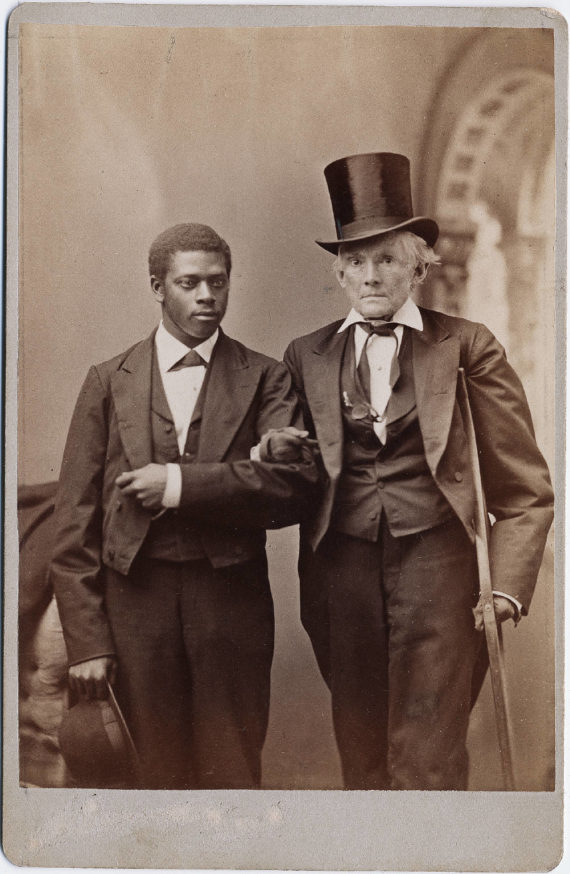Most mainstream historians point to the “Cornerstone” speech by Alexander Stephens as the clearest piece of evidence that slavery and white supremacy alone were the reasons for Southern secession. After all, most transcriptions show Stephens having stated that the Confederate government was founded on the “great physical, philosophical, and moral truth” of white superiority.
A major quote that the historians leave out of their interpretation, however, is Stephens’ assertion twice that “This truth has been slow in the process of its development, like all other truths in the various departments of science.” This science Stephens referred to was actually based on NORTHERN pseudoscience on race at the time.
One such Northern scientist was Samuel George Morton, from Philadelphia. Morton owned a large collection of skulls from around the world and by the 1830s was using the measurements of the skulls to argue there were distinct differences in the origins of the races, he also used the size of skulls to argue which races were inferior. This pseudoscience was expanded on by Josiah Nott, who was born in South Carolina, but came from a wealthy Connecticut family and was educated at the University of Pennsylvania. Nott took these ideas even further by stating that the races were separate in the way that apes are distinct from humans.
We saw this type of “scientific racism” on full display in the recent film Django Unchained, where Leonardo DiCaprio played a Southern plantation owner named Calvin Candie. In the film, Candie used skulls to argue that blacks were inferior and even enjoyed watching vicious “mandingo fights” between slaves. Whether we realize it or not, this is the type of subtle programming that is being used to convince the world the South is nothing more than a cultural wasteland of racists.
The fact is that the South is the more like the real “melting pot” of America, and the real divisive racism has mostly come from the North throughout American history. Even though the North has historically been described as the area of “free states,” blacks faced much discrimination and violence there. In some Northern states, gradual emancipation extended slavery long after it was abolished by state acts. See the following table for details:
| Northern State | Year of Gradual Abolition Acts | Year the Last Slave Died or Was Freed |
| Pennsylvania | 1780 | 1850 |
| Rhode Island | 1784 | 1842 |
| Connecticut | 1784 | 1848 |
| New York | 1799 | 1827 |
| New Jersey | 1804 | 1865 |
To hold slavery alone as the cause for a war, when some Northern states maintained slavery just ten years before the secession crisis, is absurd. It shows us that some people need to feel good about their own history, they need to think that the North fought a righteous crusade. In an essay titled Fifth Avenue, Uptown from Esquire Magazine in 1960, James Baldwin (a prominent black writer and social critic) had the following to say about this peculiar Northern racism and the true relationship of blacks and whites in the South:
“Northerners indulge in an extremely dangerous luxury. They seem to feel that because they fought on the right side during the Civil War, and won, that they have earned the right merely to deplore what is going on in the South, without taking any responsibility for it; and they can ignore what is happening in Northern cities because what is happening in Little Rock or Birmingham is worse. Well, in the first place, it is not possible for anyone who has not endured both to know which is ‘worse.’ I know Negroes who prefer the South and white Southerners because ‘At least there, you haven’t got to play any guessing games!’…I know another Negro, a man very dear to me, who says with conviction and with truth, ‘The spirit of the South is the spirit of America.’ He was born in the North and did his military training in the South. He did not, as far as I can gather, find the South ‘worse,’ he found it if anything, all too familiar…there is but one great difference between the Southern white and the Northerner: the Southerner remembers, historically and in his own psyche, a kind of Eden in which he loved black people and they loved him. Historically, the flaming sword laid across this Eden is the Civil War.”
Most academics would get triggered over Baldwin’s statement today, but there is truth to his words. For example, Alexander Stephens was reputed to have a good relationship with his slaves and once successfully defended a female slave from an attempted murder charge. At the end of The War Between the States, Stephens was imprisoned at Fort Warren in Boston harbor for five months. When he returned home, none of his former slaves had left and some remained until his death.
In his recollections that were written during his prison term, Stephens reflected on his slavery commentary in the Cornerstone speech and wrote: “The status of the African race in the new Constitution was left just where it was in the old; I affirmed and meant to affirm nothing else in this Savannah speech.” Basically, he had stated the status of African Americans was not changing under the Confederate Constitution.
Stephens’ statements on the equality of the races were widely held around the entire Union, even by men like Abraham Lincoln. It makes no sense that a man like Alexander Stephens, who lived among black people his entire life, is currently considered a white supremacist while Lincoln is not. Lincoln wanted the western territories to be open exclusively to white men, planned to colonize blacks in Africa up until his death, tried to free slaves where he had no power and freed none in territory he controlled, and explicitly stated his preference for white superiority in his debates with Stephen Douglas. While Alexander Stephens should be criticized for his acceptance of racist Northern pseudoscience in the Cornerstone speech, focusing only on his words about race detracts from its true purpose.
When this speech was delivered in Savannah in late March of 1861, it was reinforcing most of the points from Georgia’s Declaration of Secession two months earlier. One of the most important things Stephens’ described is that the Confederate Constitution eliminated burdensome tariffs and forbid the federal government from spending on internal improvements. He referred to the tariff as “The old thorn” and used the Georgia Railroad as an example, stating: “The cost of the grading, the superstructure, and the equipment of our roads was borne by those who had entered into the enterprise…we were compelled to pay into the common treasury several millions of dollars for the privilege of importing the iron, after the price was paid for it abroad. What justice was there in taking this money, which our people paid into the common treasury on the importation of our iron, and applying it to the improvement of rivers and harbors elsewhere?”
Georgia’s Declaration of Secession was approved on January 29, 1861 and went into far greater detail on the issue of tariffs:
“The material prosperity of the North was greatly dependent on the Federal Government; that of the South not at all. In the first years of the Republic the navigating, commercial, and manufacturing interests of the North began to seek profit and aggrandizement at the expense of the agricultural interests. Even the owners of fishing smacks sought and obtained bounties for pursuing their own business (which yet continue), and $500,000 is now paid them annually out of the Treasury. The navigating interests begged for protection against foreign shipbuilders and against competition in the coasting trade. Congress granted both requests, and by prohibitory acts gave an absolute monopoly of this business to each of their interests, which they enjoy without diminution to this day. Not content with these great and unjust advantages, they have sought to throw the legitimate burden of their business as much as possible upon the public; they have succeeded in throwing the cost of light-houses, buoys, and the maintenance of their seamen upon the Treasury, and the Government now pays above $2,000,000 annually for the support of these objects. These interests, in connection with the commercial and manufacturing classes, have also succeeded, by means of subventions to mail steamers and the reduction in postage, in relieving their business from the payment of about $7,000,000 annually, throwing it upon the public Treasury under the name of postal deficiency. The manufacturing interests entered into the same struggle early, and has clamored steadily for Government bounties and special favors.”
Clearly, Stephens’ was reaffirming his state’s rationale for secession when putting his speech together. He also detailed some of the ways the Confederate Constitution would be more efficient than the old: It changed the length of the president’s tenure to six years in order to “remove from the incumbent all temptation to use his office or exert the powers confided to him for any objects of personal ambition.” It also allowed cabinet ministers and heads of departments to have the privilege of seats upon the floor of the Senate and House of Representatives for debates and discussions.
Slavery is mentioned five times in the Cornerstone speech, but the word “revolution” is also mentioned five times. When the speech is really broken down, the word Constitution is mentioned thirty times, States are mentioned over twenty times, and the speech even explicitly mentions “Our object is peace, not only with the North, but with the world.”
The Cornerstone speech highlights the selective and narrow lens through which most people choose to look at history. This speech, which does show the darker side of equality at the time, does not present any uniquely Southern ideas on race. Many people would rather feel good and believe a lie, than feel uncomfortable and know the truth.








You have pointed out that there are racists in Northern states, to which not a single person would argue otherwise. But how must this mean that the institution of slavery was not the central issue of the Civil War? You failed to answer. Indeed, both things being true is not a contradiction.
Mr. Wilkes, had you said that the central issue of secession was slavery, although only four states mentioned it in their ordinances, then I could somehow agree with you. However, the Civil War “ugh” was to prevent the South from leaving. There is no contradiction in that.
The issue of slavery was central to secession (the reason the south left the union) not to the reasons for the war. In 1860, Anti-Slavery was the predominant position of the north but what did that mean at that time. Anti-Slavery meant you were okay with slavery in the south. It was not okay in the western territory as that was for free white labor only. Northerners did not want slaves or free blacks in the territory. This was a as the Marxist historians would say a racist position. The question is why were they okay with it in the south but not okay with it in the territory. The answer is about gaining a northern advantage in Congress. The North wanted a Commercial Republic. They wanted subsidies for business and bondholders, they wanted a national bank and they wanted a protectionist tariff instead of a revenue tariff to protect northern industry. If they could limit immigrants from the south, new states would side with the north on the political economy. To do this, they needed to attract racist northerners and prevent southern immigration.